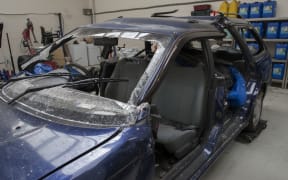The inquest of Rutger Hale has left many questions hanging about the deadly object that killed him but has been described as like a brick or as big as a cannonball.

Danielle Oylear said the object was "rocketing towards us" and she heard a loud noise like a crunch. Photo: RNZ / Ian Telfer
The 22-year-old was driving with partner Danielle Oylear on the Lake Hawea-Albert Town Road, near Wanaka, on 24 October last year when the object punctured the windscreen, striking him in the head, before smashing through the back window.
Ms Oylear, 26, who was physically unharmed, was able to lift his foot from the accelerator and steer the station wagon to the side of the Lake Hawea-Albert Town Road.
The object punched a fist-sized hole in the front window and has never been identified or found.

Rutger Hale had been living in the Hawea area for just a few weeks. Photo: SUPPLIED
At an inquest held in Queenstown today, six witnesses gave evidence including Ms Oylear, who was travelling in the car about 6.30am.
She told Coroner Richard McElrea she saw an oncoming white utility take a corner wide, and then a beige-coloured projectile the size of a brick or a tissue box fly at them.
Ms Oylear said she raised her arm and closed her eyes, and it took her a while to realise that Mr Hale had been hit and seriously injured.
"It was moving very fast, it was rocketing towards us, I had just enough time to register, I put my arm up in an instinctive reaction and heard a loud noise which I would describe as a crunch, a thump.
"And when I opened my eyes I saw the windscreen had been badly damaged."
Forensic pathologist Martin Sage told the inquest that he has not seen wounds like Mr Hale's in more than 30 years of practice.
Dr Sage said the object was at least semi-circular, eight centimetres wide and possibly fully spherical.
"If that was the case, then this looks very like the sort of injury that we don't get to see, but that naval surgeons or army surgeons 200 years ago would've looked at and said, 'Oh, this looks like a cannonball'".
Earlier evidence from defence and police experts suggested a partly, but not fully metallic object of stainless steel, but with orange or some black material or dirt coating it.
Mr McElrea did not make any findings today, and Rutger Hale's family says they have been left with some answers, but many more questions.



